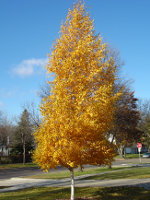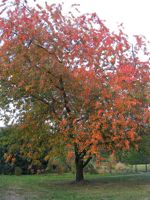Mon-Fri 9am - 5pm Mountain time
Dakota Pinnacle Birch vs Black Cherry
Betula platyphylla fargo
Prunus serotina
CUSTOM GROW
NOT AVAILABLE THIS SEASON - MIGHT RETURN
Dakota Pinnacle Birch is a hardy deciduous tree with a columnar to narrowly pyramidal form. It makes a beautiful accent tree, and Dakota Pinnacle Birch is insect resistant and drought tolerant.
Dakota Pinnacle Birch features smooth white bark and dark, green foliage that turns yellow in the fall.
Black Cherry is common in eastern North America but a rare find elsewhere. This tree is shade tolerant and is often found in old fields, forest openings, and along fencerows.
The fruit is edible and is commonly used to flavor rum and brandy. It is also edible and often eaten fresh or used in wine or jelly. Black Cherry trees typically begin producing fruit when they are 10 years of age.
Black Cherry wood is a rich reddish-brown color and is strong, making it valued in cabinetry and woodworking. It is often used in reclamation as well.
The leaves can poison livestock as they contain cyanide derivatives and precursors. However, many have noted that deer still seem to browse their trees with impunity and birds and other animals eat the fruit when available.
Dakota Pinnacle Birch Quick Facts
Black Cherry Quick Facts
Toxicity: bark and wilted leaves toxic to livestock
In row spacing: 1.8 - 2.4 m (6 - 8 ft)

